
The main role of a coach is to help the coachee realize their current state of mind and move the coachee from his current comfort zone to recognize their fullest potential by traversing the path of learning zone. The coachee hits the learning zone when he moves from being “less skilled and less willed to less skilled and more willed” and eventually moves to the “magic zone” by acquiring more skill and will.
Comfort zone – This zone represents a safe, comfortable, familiar, secured zone in which the coachee has acquired competence. The coachee is unware of his lack of skills and will in the unfamiliar areas/areas of incompetence.
“Less skilled and less willed”—The coachee becomes aware of his lack of skills and feels insecure, hence less willed. This state is also called conscious incompetence.
Learning Zone–In this zone the coachee is in the state of mindfulness, open to learn, and more confident, otherwise known as “less skilled and more willed.”
Magic Zone–This zone represents a state in which the coachee has acquired the skills and is fully competent and hence feeling secured and willing: “more skilled and more willed.” The Magic Zone is a place where the coachee has gone through insight leading to “aha” effects and realizing his potential.
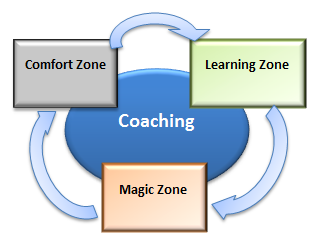
In this process of crossing the learning zone, the coachee becomes aware of his current state of comfort zone (“less skilled and less willed”) because of the new skill/behavior that the coachee has to adopt. Having realized the required skill and will at the new level (conscious incompetence), the coachee is bound to feel insecure, which in turn will affect the coachee’s self-confidence, self-obligation and self-motivation levels.
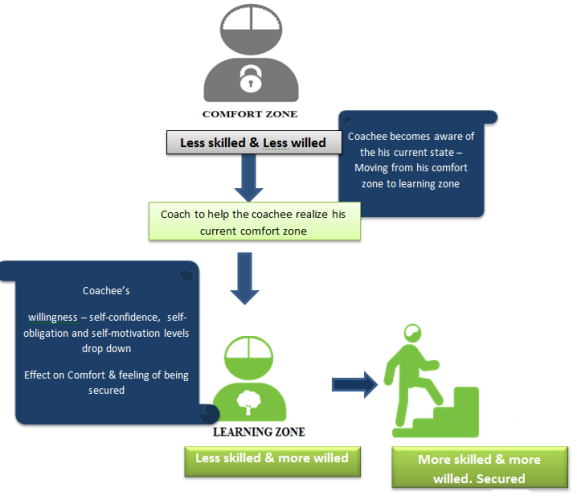
The coach will have to recognize the conscious incompetence stage of the coachee and will have to facilitate to quickly move the coachee from “less skilled and less willed” to “less skilled and more willed.” This will have a direct impact on the coachee’s feelings of willingness as well as security levels. Having moved the coachee from “less skilled and less willed” to “less skilled and more willed,” the coach now has to help the coachee move to be “more skilled and more willed.”
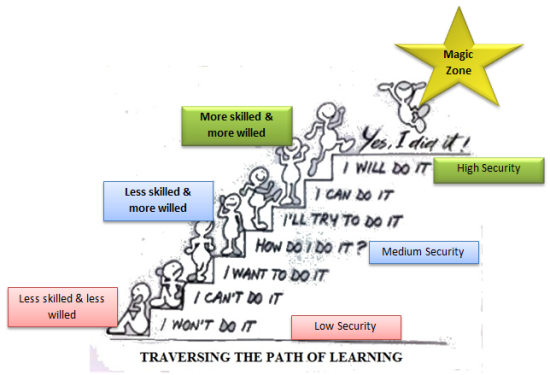
Although the previous section talks about moving the coachee from less skilled and less willed (the comfort zone) to more skilled and more willed (having traversed the path of learning zone), this is an ideal scenario. In a real time, the coachee may be at different points between skill and will and the corresponding effect will be seen in their security levels. I.e. the coachee will be at different levels of comfort and security in his travel of moving from “comfort zone to learning zone” and eventually reaching the “magic zone.” The magic zone is a place where the coachee has gone through insight leading to “aha” effects and realizing his potential. However staying in this “magic zone” for a longer time will move back the coachee to his comfort zone, since the skill acquired becomes routine and can be performed without too much challenge. Hence it is the job of the coach to help the coachee to traverse the path of learning zone frequently.
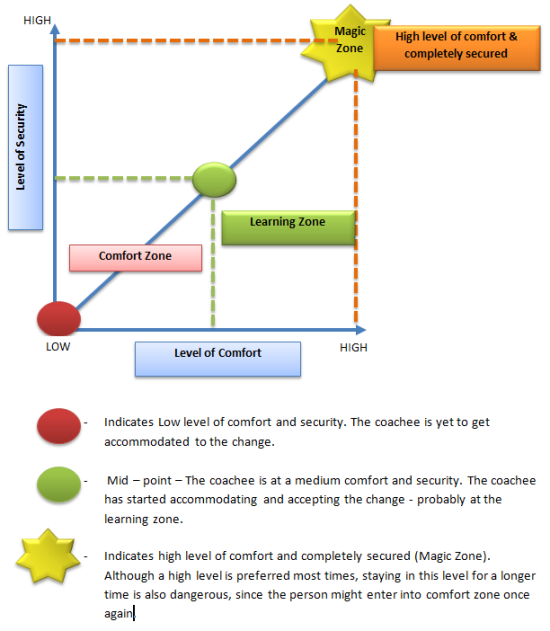
Having reached the magic zone, the coachee has to stretch further to explore more of his potential in order to achieve his self-actualization need. The process of growth is learning to step down from the magic zone to learning zone while being aware of the impact that it will have on the coachee’s skill, will and security.
>The process of moving coachee from his comfort zone to the magic zone via the learning zone, and helping the coachee to travel via the learning zone more often, can be compared to the biological functions of a heart and a lung.
The heart collects impure blood (deoxygenated blood) from all parts of the body and pumps it to pulmonary arteries of the lungs to purify the blood. The lungs in turn supply the pure blood (oxygenated blood) back to heart to be supplied to rest of the body. This is a constant cyclical process by which the deoxygenated blood in our body is removed and being resupplied with oxygenated blood to ensure normal functioning of our body and other organs.
The Heart: The heart can be compared to a coach since the coach helps the coachee identify areas of potential improvement (deoxygenated blood) and to traverse the path of learning zone more frequently, thereby helping the coachee to attain his self-actualization need (oxygenated blood).
The Lungs: The lungs can be compared to the coachee because having identified areas of growth and improvement with the help of coach (deoxygenated blood pumped from heart), the coachee takes small steps to move from his comfort zone to the learning zone and eventually to the magic zone. (deoxygenated to oxygenated blood)
Deoxygenated Blood: The coachee’s comfort zone – less skilled and less willed
Oxygenated Blood: The coachee traversing the learning zone – more skilled and more willed
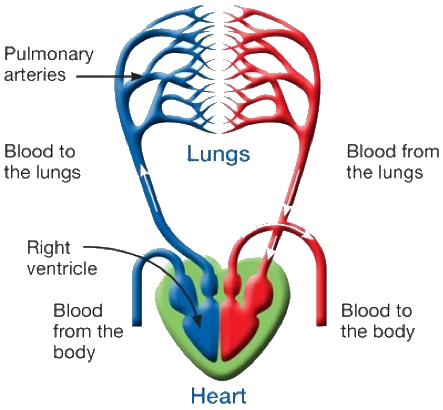
Similarly, the process of change (moving from the comfort zone to the magic zone via the learning zone) has to happen constantly to ensure that the person attains maximum growth.
Managing the movement:
During the process of the coachee moving from his comfort zone to the magic zone, on account of low security levels the coachee might experience any or all of the following:
The coach can manage the above stated situation using the following tools and process.
Managing emotions and feelings:
The state of being less skilled and less willed compounded with low security levels can cause a person to relate with a coach from emotions and feelings. It is critical that the coach focuses on helping the coachee suspend his emotions and move to thinking. This will enhance coaching effectiveness in this situation. The progress of moving from emotions to thinking and relating to people is explained in the blog “The MinddKai® Model.”
Managing less active and less engaged:
During the process of coachee’s movement from his current comfort zone (less skilled and less willed) to a learning zone (less skilled and more willed) eventually to the magic zone (more skilled and more willed), it is important that the coach ensures the coachee is both engaged and active. This will ensure the coachee sustains the progress as he traverses the path of learning. (Refer blog “A coaching tool for Mindful engagement” published on September 23rd).
Managing the perceived threat of coaching questions:
As the coachee would be traversing the path of learning with less security coaching questions based on DEAL O technique can minimize threat (refer blog “Framing coaching questions based on DEAL O technique” published on September 30th).
Managing the perception vs reality:
As the coachee can define situations as “real” and experience the situation in real as consequence, coach must be aware of the phenomena as stated in “Thomas Theorem” (refer blog “Thomas Theorem in coaching to be published on November 19th).
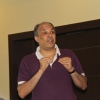
R R Krishna has about 30 years of work experience in Human Resources spanning different industries. He is a PCC, (ICF), RPCC (RCS), CMC (BCI/ICC) with 15 years of coaching experience and also member of International Association of Coaching, Asia Pacific alliance of coaches and Association of Coaching. Find more about Krishna at www.rrkrishna.com.

Haritha Priyaadarshini T, B.Tech Biotechnology Graduate and a MBA in Human Resource Management with a work experience of 5 years in people development. She currently works for a Multinational in the area of Human Resource Development.
Registered office
119, (old 65) P S Sivaswamy Salai
Mylapore
Chennai : 600 004
Mobile : 98407-20188
Email: rrk@pghrs.com